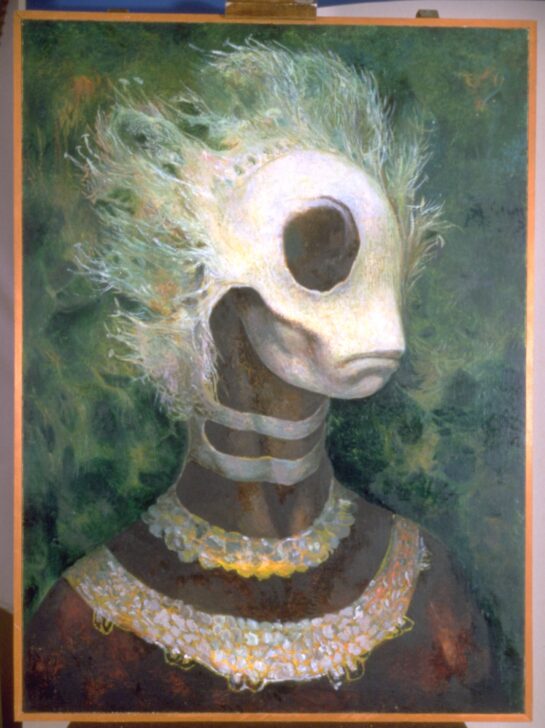Ah Puch
Guillermo Meza

Description
President's House object Summary
The Mexican artist Guillermo Meza apprenticed in his father's tailor shop while studying art and music at the Escuela Nocturna de Arte para Trabajadores (Art Night School for Workers). After moving to Morelia, a city in the state of Michoacan, Meza continued his studies and was fortunate to meet Diego Rivera in 1940. Rivera helped to arrange Meza's first one-man exhibition at the Galeria de Arte Mexicano, an important venue in Mexico City. Meza was represented in international exhibitions beginning in the 1950s and worked later in his career with dance and theater companies, both in Mexico and abroad. He also served as president of the First National Congress of Visual Artisits. Meza described his vocation as: "My eyes, my hands, my brain we made for painting, and only painting can settle my drive."
In this work, Meza refers to an ancient subject: Ah Puch, a malevolent underworld deity of Mayan religion. The god of death, Ah Puch ruled over Mitmal, the land of the dead, and appears in pre-Conquest codices along with the god of war in scenes of human sacrifice. Generally pictured as a human with an owl's head, he is also pictured as a skeleton-like being. With a large cancas and the somber, mysterious disposition of the figure, Meza has created an ominous, threatening image that invokes something of the fear and violence of the ancient world.
(Agnes Miner, Ann Sinfield)
Subject Matter:
As the title suggests, this is a portrait of one of the Mayan death gods, Ah Puch. This is a skeleton-like being, the patron of the sixth day-sign Cimi, and Lord of Hell. This subject matter is not only a depiction of the god, however, but also a more general image of Mexican culture. Meza's depiction reflects the role the skeleton mask plays as a powerful symbol in Mexican culture. This work is indicative of Meza's engagement with Surrealism and, what has been termed Magic Realism. The painterly quality of the background conjuries images of storm clouds. Like many of the Mayan gods, Ah Puch also had benevolent qualities as a bringer of rain and fertility.
Physical Description:
Bust of a figure from the chest up in three-quarters pose. The head, or perhaps a mask, is white, resembling a skull with a halo of white hair. The neck is dark brown with two white bands like chokers around it, perhaps securing the mask. The figure wears a dark red garment that is trimmed in ornate lace in white and gold. The background is a deep teal green-blue.
Usage Rights:
If you are interested in using an image for a publication, please visit https://umma.umich.edu/request-image/ for more information and to fill out the online Image Rights and Reproductions Request Form.